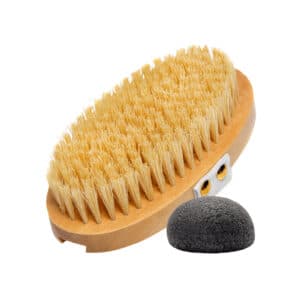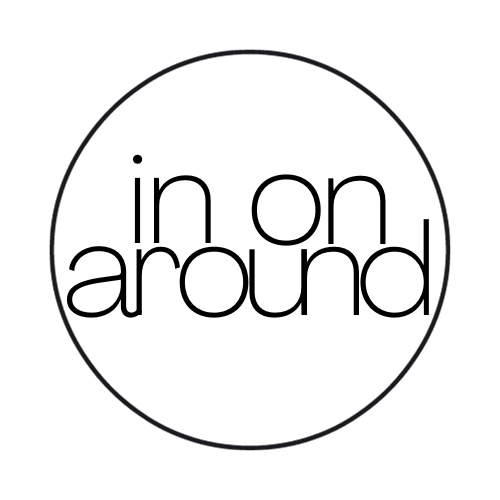Based on ancient Ayurvedic rituals, dry brushing is a wonderful practice and a great addition to your routine! While the practice has been regularly used for hundreds of years, it’s gaining popularity again… and for good reason! But what’s all the hype about? Does dry brushing really impact your health? Who should avoid it? Keep reading to learn more about how to dry brush for detox!
This article dives deep into it all!

Note: This article contains affiliate links, meaning In On Around will make a small commission at no additional cost to you. This helps me maintain the site. As always, I value full transparency & only work with brands I love and trust.
What Is Dry Brushing & What Are The Health Benefits?
Dry Brushing involves brushing your skin with firm bristles (as pictured above) in an effort to assist the lymphatic system. It’s called a “dry” brush because you don’t use any water to dampen the skin. It’s a very dry brush!
Dry brushing is known to…
- Exfoliate the skin (encourages radiant smooth skin)
- Increase blood circulation
- Promote movement and drainage of lymph fluid (lymphatic support)
- Stimulate the nervous system (can calm nerves)
- Encourages cell renewal
- Potentially reduce cellulite (although research is limited right now)
- Help with stress relief & self-care
… and many more! It’s an excellent full-body routine. In fact, if done properly, it can actually be gentler on your skin than exfoliating in the shower. Hot water can inflame the skin and dry it out.

What Is The Lymphatic System?
The lymphatic system (which includes our lymphatic fluid, lymph nodes, vessels, and collecting ducts) is essential for our immune system & it helps our body detoxify. This super important bodily function flushes out toxins and waste from our bodies. We don’t want these toxins accumulating (this is when problems arise, like swelling/lymphedema & even cancer)!
In fact, we have a lot of lymph nodes throughout our body (about 600 to be exact!) – dry brushing is a great way to support the detox process.
We have about 600 lymph nodes throughout our body.
So How Do You Properly Dry Brush?
- Make sure your skin is completely dry
- Start at your feet and slowly brush your skin in long upward strokes towards your heart. Make sure you don’t forget the tops of your feet. Lymph fluid re-enters the bloodstream in your chest – this is why it’s essential to “push” it towards your heart.
- Follow the same process for your arms. Start at the back of your hands and with long strokes work your way up towards your armpits.
- Be very gentle around your neck. Start at the jawline and brush down towards your chest.
- Don’t forget your stomach! Brush downwards when below the belly button & upwards when above the belly button.
- Make sure you gently brush both the front & back of your body.
Dry Brushing: How-To Graphic
For visual learners, the below graphic is an excellent representation of how to properly dry brush!

Photo from: Prana
Should You Dry Brush Your Face?
No, it is not recommended to dry brush your face. Dry brushing can oftentimes be too abrasive and leave micro-cuts. Dry brushing your face can oftentimes over-exfoliate, leaving your skin barrier disrupted and extra sensitive. Avoid the face where you can!
How Often Should You Dry Brush?
Since dry brushing involves exfoliating your skin, it’s usually best to dry brush about 1 to 2 times per week. If your skin is particularly sensitive, start slow and note how your skin feels – you may only be able to handle it every couple of weeks. You don’t want to cause skin irritation!
If your skin reacts well to dry brushing, you can dry brush lightly every day, however, use caution. It’s best to avoid over-exfoliation.

When Is The Best Time To Dry Brush?
The best time to dry brush is right before you hop in the shower! Make sure you lather on some non-toxic moisturizer and sunscreen after your shower as always.
I like to dry brush in the morning… it’s a great way to help your body wake up & it’s a nice addition to a slow, stress-free morning routine.
Who Should Dry Brush And Who Should Avoid It?
For most people, dry brushing can be a great practice to incorporate into your day! If you’re experiencing lumph pooling in your legs or extremities, dry brushing may help!
Certain people should avoid dry brushing.
However, if you have open cuts, sores, an infection, irritation, or a skin condition (like psoriasis and eczema) it’s best to avoid it. If you have any moles, warts, or blemishes, avoid those areas as well. You never want to introduce bacteria to open wounds, or further irritate sensitive skin. Use caution if you have hypersensitive skin. Women who are pregnant and nursing should also discuss dry brushing first with their doctor.
Be careful not to push too hard with the brush. The strokes should use medium pressure (just enough to not cause skin irritation). Make sure you listen to your body and only do what is comfortable.
What Kind Of Dry Brush Should You Buy?
I use my brush from Popchose – it’s affordable, great quality, and very easy to grip (note: the Popchose brush is made from boar bristles, so it is not vegan). I also have an exfoliation mitten which can provide some of the same benefits, however, it’s not as coarse as a true dry brush. If a dry brush is too rough on your skin, try giving the mitten a try.
If you’re looking for a VEGAN dry brush (made with sisal bristles, which are plant-based and slightly more firm):
- Osea has a great dry brush! Use code “inonaround” for 10% off
- Belula also has a great vegan dry brush (also comes with a konjac sponge)
Make sure to keep your brush clean & dry. If water or humidity is exposed to it, it can be a breeding ground for bacteria (yuck!). If you need to clean the brush, use a dry rag or cloth to wipe it clean. It’s best to do this after every session is possible.
Keeping your brush clean and dry is key!
Dry Brushing For Skin Health – Frequently Asked Questions
Click on the below FAQs to learn more about how to dry brush for detox!
What is dry brushing?
What are the benefits of dry brushing?
How do you properly dry brush?

To properly begin dry brushing, make sure your skin is dry. Start at your feet and slowly brush your skin in long upward strokes towards your heart. Make sure you don’t forget the tops of your feet. Lymph fluid re-enters the bloodstream in your chest – this is why it’s essential to “push” it towards your heart.
How often should you dry brush?
What's the best time to dry brush?
Who should avoid dry brushing?

For most people, dry brushing can be a great practice to incorporate into your day! However, if you have open cuts, sores, an infection, irritation, or a skin condition (like psoriasis and eczema) it’s best to avoid it. You never want to introduce bacteria to open wounds, or further irritate sensitive skin.
What's the best kind of dry brush?
Have you tried dry brushing?
It’s clear that dry brushing is a great way to support your immune system! Now you know how to dry brush for detox!
Let me know in the comments below! You can watch our web story here.
xoxo,

Want to read more? Check out my other articles here!
Information on “How To Dry Brush For Detox” from Cleveland Clinic, Byrdie, Prana Brush, EVMS
Copyright In On Around LLC 2021 © The statements made on this website have not been evaluated by the FDA (U.S. Food & Drug Administration). They are not intended to diagnose, treat, cure, or prevent any disease. The information provided by this website should not be used as individual medical advice and you should always consult your doctor for individual recommendations and treatment.






One Response